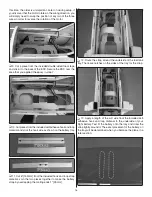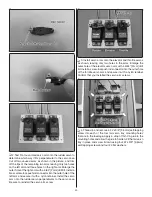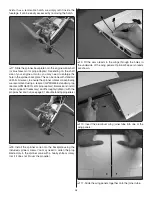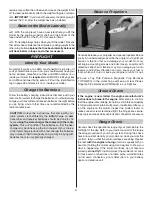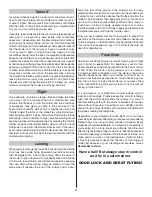
30
If your radio does not have dual rates, we recommend setting
the throws at the low rate settings for your fi rst few fl ights.
We suggest waiting until you are accustomed to the fl ying
characteristics of the Avistar before changing to high rates.
Balance the Model (C.G.)
More than any other factor, the C.G. (center of gravity/
balance point) can have the greatest effect on how a model
fl ies and could determine whether or not your fi rst fl ight will
be successful. If you value your model and wish to enjoy it
for many fl ights,
DO NOT OVERLOOK THIS IMPORTANT
PROCEDURE.
A model that is not properly balanced may
be unstable and possibly unfl yable.
At this stage the model should be in ready-to-fl y condition
with
all
of the components in place including the complete
radio system, engine, muffl er, propeller, and spinner (the fl ight
battery should be in place if you installed a brushless motor).
If you’ve built the glow version the fuel tank should be empty.
❏
1. If using a Great Planes C.G. Machine, set the rulers to
3-5/16" [84mm]. If not using a C.G. Machine, use a fi ne-point
felt tip pen to mark lines on the underside of the wing on both
sides of the fuselage 3-5/16" [84mm] back from the leading
edge. Apply narrow (1/16" [2mm]) strips of tape over the lines
so you will be able to feel them when lifting the model with
your fi ngers.
This is where your model should balance for the fi rst
fl ights. Later, you may experiment by shifting the C.G. 3/8”
[9.5mm] forward or 3/8” [9.5mm] back to change the fl ying
characteristics. Moving the C.G. forward will improve the
smoothness and stability, but the model will then be less
aerobatic (which may be fi ne for less-experienced pilots).
Moving the C.G. aft makes the model more maneuverable
and aerobatic for experienced pilots. In any case,
start at
the recommended balance point
and do not at any time
balance the model outside the specifi ed range.
❏
2. With the wing attached to the fuselage, all parts of the
model installed (ready to fl y) and an empty fuel tank, place the
model on a Great Planes CG Machine, or lift it at the balance
point you marked.
❏
3. If the tail drops, the model is “tail heavy.” If the nose
drops, the model is “nose heavy.” The receiver battery could
be moved forward or aft inside the fuselage to shift the balance
point of the model toward the recommended balancing point.
If the receiver battery cannot be moved, or if additional weight
is still required, nose weight may be easily added by using
“spinner weight” (GPMQ4645 for the 1 oz. [28g] weight, or
GPMQ4646 for the 2 oz. [57g] weight). If spinner weight is
not practical or is not enough, or if tail weight is required,
use Great Planes “stick-on” lead (GPMQ4485). To fi nd out
how much weight is required, place incrementally increasing
amounts of weight on the top of the fuselage over the location
where it would be mounted inside until the model balances.
A good place to add stick-on nose weight is to the fi rewall.
Once you have determined the amount of weight required,
it can be permanently attached. If required, tail weight may
be added by cutting open the bottom of the fuse and gluing
it permanently inside.
Note:
If mounting weight where it may be exposed to fuel
or exhaust, do not rely upon the adhesive on the back to
permanently hold it in place. Over time, fuel and exhaust

